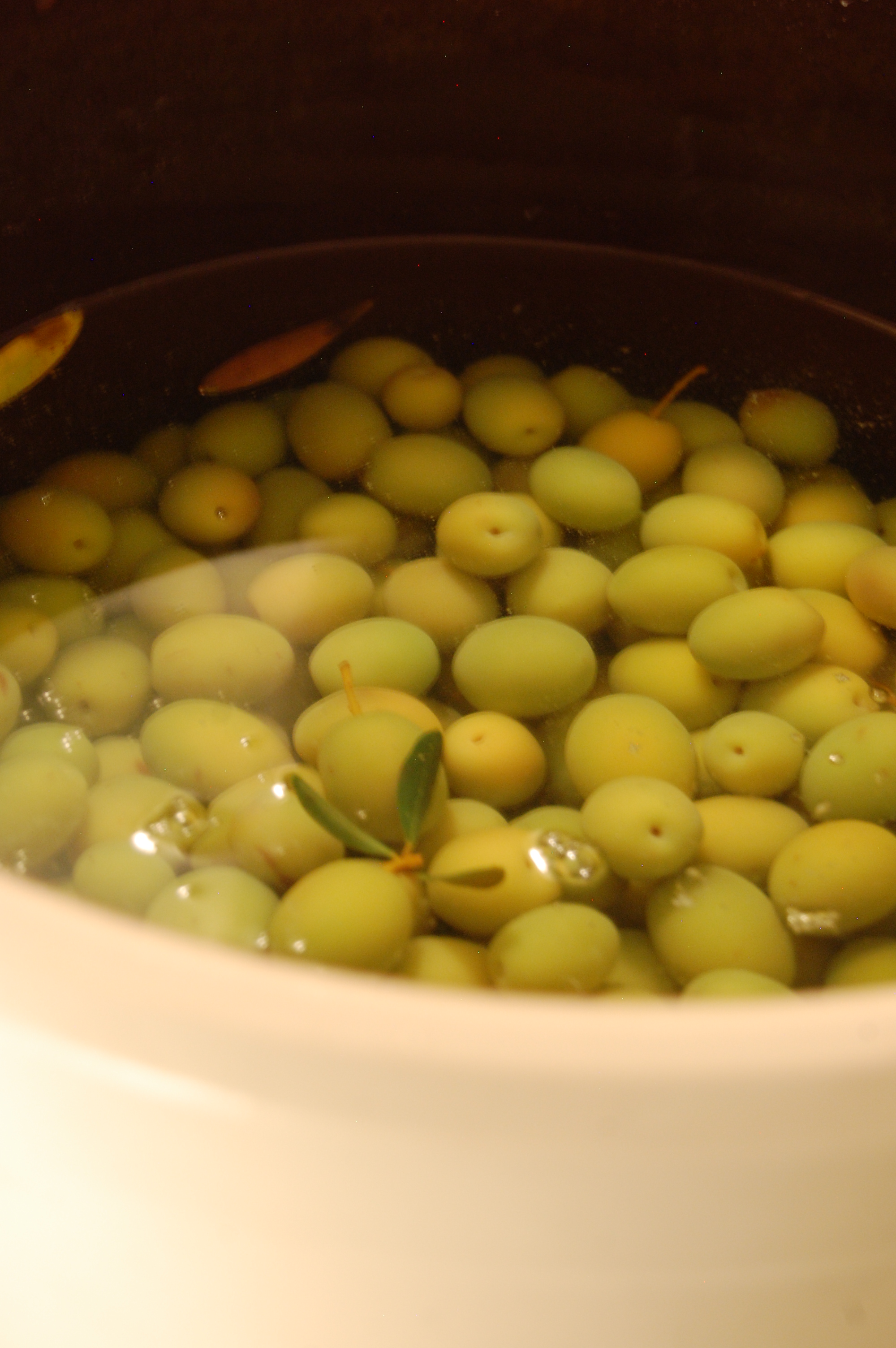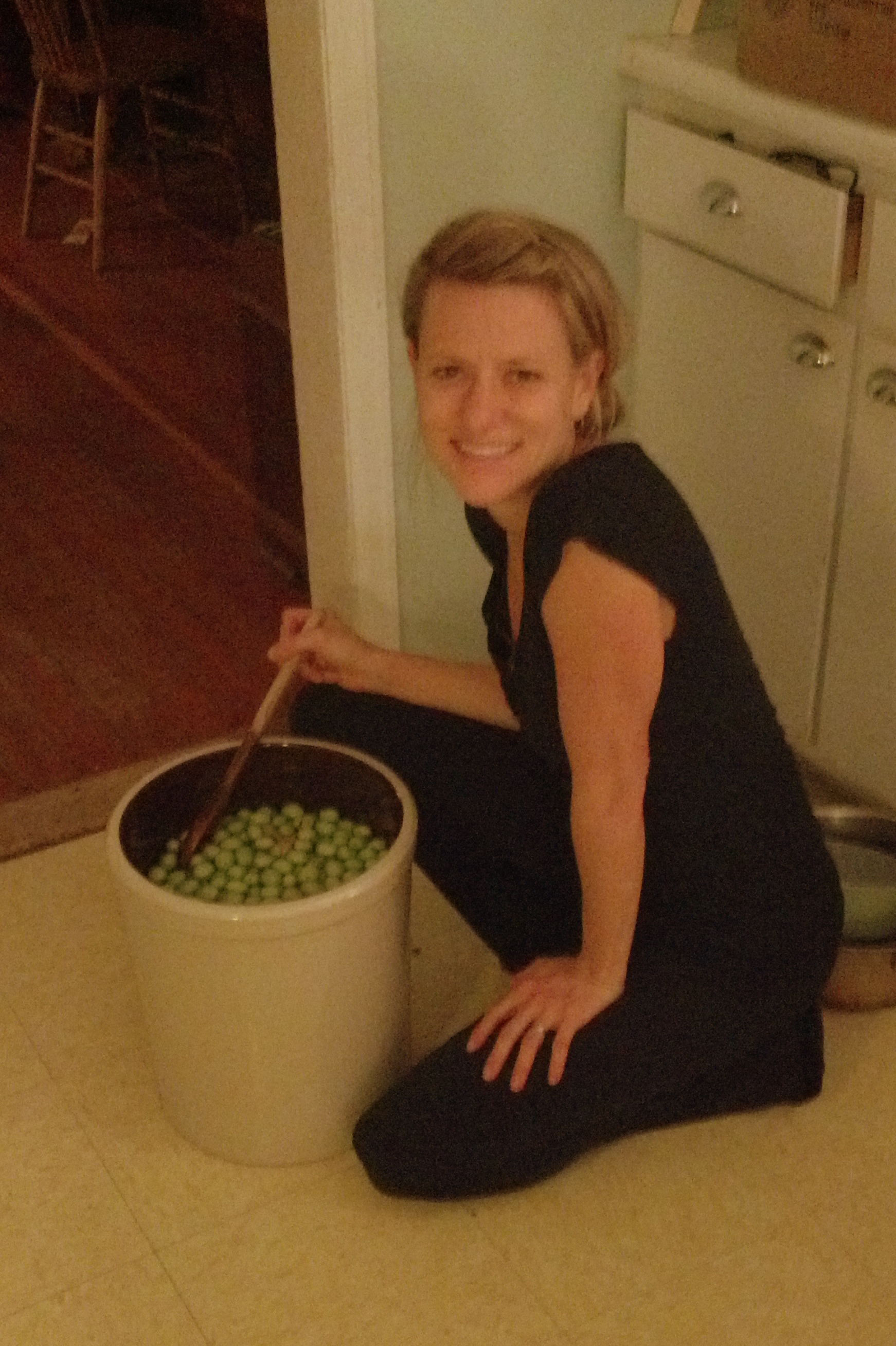Olives, beautiful olives
Do you have a taste from your childhood? Something, that when you smell it, eat it... instantly transports you back to your youth? My beautiful Mother is 100% Italian, making me half Italian... something I cherish. As much as America is beautiful in it's cultural diversity... I crave a connection to my roots. My Papa (Italian Grandfather) would come over when I was young with vegetables from his garden ... an excuse to see the grandkids, my Mom used to say. He was not at all affectionate - but he seemed to show his love through sharing food. Italian green peppers we used to fry in the pan and make ham sandwiches with... crisp, fuzzy cucumbers - (a variety I found seeds for from Italy and grew this year!), tomatoes, and..... olives.
I remember my Mom having a 5 gallon bucket full of these lovely green beauties out in the garage in the summer or fall months. Once the brining process began - to my brother and I, they were fair game. We'd sneak our little fists down into the murky salt water and come up with a handful of beautiful, shiny olives. The perfect sneaky snack when Mom said dinner wasn't yet ready.
Since my Papa passed away, the rest of our family has been relatively olive-less. We bought specialty olives from all sorts of high-end delis and grocers - hoping for that buttery, simple salty taste - but never quite found it. My Mom would even buy some that were close, drain the vinegar out of the jar and replace it with salt water. They were good, but not the exact taste we remembered. While visiting my sister in California before Christmas a couple of years ago - she opened a package from a friend, and inside were some home-cured olives. When we opened them and I tasted them... there it was... the taste. It could still be done. I needed to know how. On a drive across a couple of states with my Momma recently, I asked her if she remembered how her Dad made those olives. I wondered - could I cure my own? As she explained what she remembered about the process, I Googled.
The way Papa did it was a simple Lye cure. But was Lye - (the main ingredient in Drain-o and a soap-making ingredient) safe to use in food? Thankfully, hunteranglergardenercook had asked this question AND done the research for me. Interestingly - one of the sources of Lye is wood ash. His research, citing historical techniques since the Roman times - gave me enough confidence that it was safe. Mom read his instructions and said "Yes. This is how he did it!" I was thrilled. I would cure my own olives. But wait. I live in Colorado - a climate unfriendly to the wonderful Mediterranean crops such as citrus and olives. Back to Google. I was determined. Could I grow olives in my greenhouse? Hmmm.. I doubt a tree would get large enough to produce in there. It wasn't long before I found localharvest.org connecting consumers to local growers. A farm in CA sells fresh, raw olives, ready for curing. I signed up for the email notification and waited for them to come into season. Mine came from a beautiful farm called Chaffin Family Orchards.
Mid- October came and I got the email about my olives. They were ready to ship. I purchased them online ($40 for 5 lbs, free shipping) and a week later - a large, flat rate box was on my Colorado front porch - brimming with these beautiful raw, green beauties!
We gathered our supplies:
- a 5 gallon stoneware crock - (purchased at a local Hardware Store) - surprise gift from my wonderful Man.
- Lye - (make sure it's 100% Lye - no added chemicals) - (purchased also at Hardware Store)
- Water
- Sea Salt
- Olives
My hubby and I worked together to sort the olives (discarding any with too much brown) and did the careful work of mixing the lye into water in our 5 gallon stoneware crock. Once that part was done - (the Lye solution MUST not touch your skin) - we were relieved. In went the olives. Now for an overnight soak (12 hours) in the Lye solution. This process draws out all of the bitterness (and the ARE bitter, I tried one) out of the olives and into the water.
 The next morning, the water was a dark brown color. Now for the rinsing. We rinse 2-4 times per day for about 4 to 6 days. Again, my Man helped me (turns out stoneware crocks are heavy when filled with olives and water). After scooping olives, draining them in colanders, immediately putting them into bowls of water (exposure to air will turn them dark) and dumping them back in - we noticed we were bruising them. Next time I will just tip the crock over the sink, while holding the olives in with a sieve so that the soapy Lye-water drains out - rinse with the sink sprayer and re-fill. This process is the most work of the entire project. (Minimal, for the reward - I think).
The next morning, the water was a dark brown color. Now for the rinsing. We rinse 2-4 times per day for about 4 to 6 days. Again, my Man helped me (turns out stoneware crocks are heavy when filled with olives and water). After scooping olives, draining them in colanders, immediately putting them into bowls of water (exposure to air will turn them dark) and dumping them back in - we noticed we were bruising them. Next time I will just tip the crock over the sink, while holding the olives in with a sieve so that the soapy Lye-water drains out - rinse with the sink sprayer and re-fill. This process is the most work of the entire project. (Minimal, for the reward - I think).
We tasted one after day two. They should taste bland and a bit soapy. Check. Now to keep rinsing until the soapy taste is gone. I thought they were good on day 5, so I added the salt water to begin brining. Hubby disagreed. He could still taste soap. No problem. Rinse again. 2 more times. A few cups of sea salt wasted, but not too shabby for a first try. Brined again - and THIS time.... aaaah.. There it is. The taste of my childhood. Lord, have mercy. I might eat them all.
I may experiment with marinating them in olive oil with herbs and garlic - maybe lemon zest and chili flakes. So far - I'm in heaven with the simple salty goodness all on their own. The other evening we had quite a spread with some wine, salami, sheep's milk cheese, home-made sourdough (tutorial to come) and olives. Life is good.
These babies are now ready to put into jars and kept stored in the fridge. I have an extra out in the garage - but if we ever put in a cold storage/cellar in the basement - that might do as well. The salt preserves them, though I read that after about 2 or 3 months at room temp they start to get a bit funky.
Hope you enjoyed my olive adventure. I'd love to hear if any of you have ever cured olives - or if you give this method a try!
-Sarah




